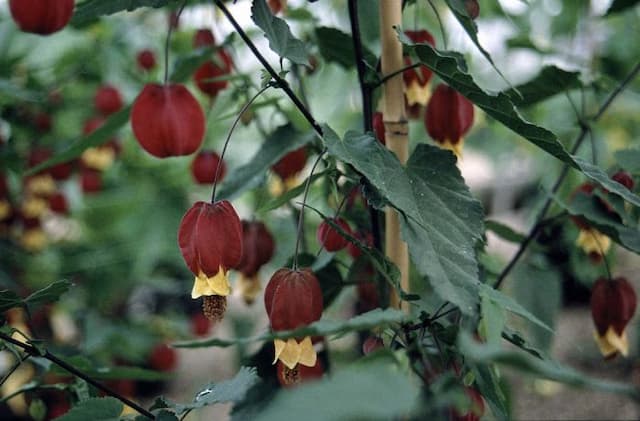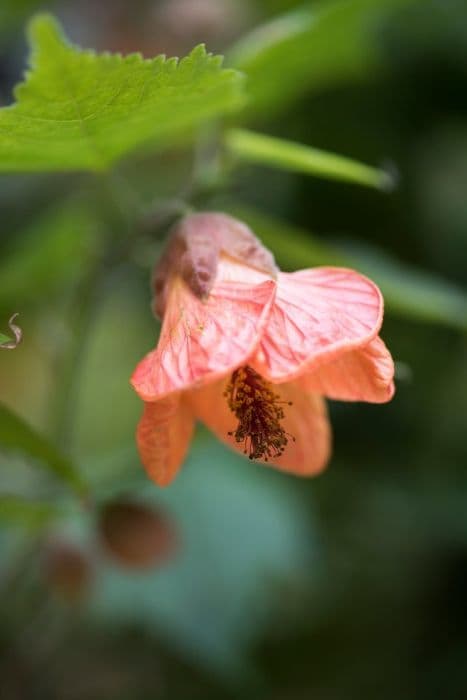Lacebark Hoheria 'Borde Hill'

ABOUT
Hoheria 'Borde Hill' is a deciduous shrub known for its attractive features throughout the year. It is characterized by its deep green, glossy leaves that have a serrated edge, giving it a delicate and lace-like appearance. The foliage is dense, providing a full and robust look. In the summer months, this plant becomes even more striking as it produces clusters of star-shaped flowers. The flowers are white and have a distinct, sweet fragrance that can attract pollinators such as bees and butterflies to your garden. These blossoms are prolific and create a stunning contrast against the dark green leaves. As the seasons change, the leaves may take on a yellow hue before falling, offering a final display of subtle autumnal color. The overall aesthetic of Hoheria 'Borde Hill' is one of elegance and charm, making it a delightful addition to any landscape that seeks a touch of natural beauty with year-round interest.
About this plant
 Names
NamesFamily
Malvaceae
Synonyms
Lacebark, Ribbonwood
Common names
Hoheria 'Borde Hill'.
 Toxicity
ToxicityTo humans
Hoheria, commonly known as lacebark, has no well-documented toxicity to humans. Ingesting any part of the plant is unlikely to cause serious harm, but, as with any plant not intended for consumption, it is possible that some individuals might experience mild stomach upset or an allergic reaction if they are particularly sensitive to the plant.
To pets
Lacebark is not commonly listed as toxic to pets. However, as with humans, the ingestion of plant material by pets that are not normally part of their diet could potentially lead to gastrointestinal upset or an allergic reaction in sensitive individuals. If you suspect your pet has eaten a significant amount of lacebark and is showing adverse symptoms, it is best to consult a veterinarian.
 Characteristics
CharacteristicsLife cycle
Perennials
Foliage type
Semi-deciduous
Color of leaves
Green
Flower color
White
Height
15-20 feet (4.5-6 meters)
Spread
10-15 feet (3-4.5 meters)
Plant type
Tree
Hardiness zones
8
Native area
New Zealand
Benefits
 General Benefits
General Benefits- Attracts Wildlife: Hoheria 'Borde Hill', commonly known as Lacebark, provides habitat and food for various species of birds and beneficial insects.
- Aesthetic Appeal: The plant has attractive foliage and beautiful white flowers that can enhance the visual appeal of gardens and landscapes.
- Shade and Shelter: Lacebark can grow into a medium-sized tree, offering shade and shelter under its canopy during sunny days.
- Privacy Screening: When grown as a hedge or screen, Lacebark can provide privacy for gardens and outdoor spaces.
- Low Maintenance: It is generally easy to care for and does not require excessive pruning or maintenance, making it suitable for gardeners of all skill levels.
- Suitable for Diverse Climates: Lacebark is capable of adapting to a range of climates, making it a versatile choice for many gardens.
- Erosion Control: The root system of the plant can help stabilize soil and prevent erosion on slopes and banks.
- Seasonal Interest: Lacebark offers seasonal interest with its changing foliage, flowers, and, sometimes, seed pods, which can attract attention throughout the year.
 Medical Properties
Medical PropertiesThis plant is not used for medical purposes.
 Air-purifying Qualities
Air-purifying QualitiesThis plant is not specifically known for air purifying qualities.
 Other Uses
Other Uses- Lacebark fibers: The bark of lacebark can be processed to extract fibrous material, which has been traditionally used by indigenous Maori in New Zealand for making textiles, baskets, and nets.
- Nectar source for bees: Lacebark flowers are rich in nectar, making them attractive to bees and other pollinators, which can help support local ecosystems and increase bee populations.
- Educational tool: Lacebark, due to its unique properties and native status in New Zealand, can be used in educational settings to teach students about botany, traditional uses of plants, and conservation efforts.
- Biomimicry inspiration: The structure and resilience of lacebark's fibrous bark can inspire materials scientists and engineers in designing sustainable, strong materials based on natural models.
- Craft material: The wood of lacebark is lightweight and can be used in crafting small wooden objects, such as frames or decorative items.
- Insect habitat: Lacebark trees provide shelter and breeding sites for a variety of insects, which are integral to the health of local environments and food webs.
- Bonsai: Enthusiasts may use smaller lacebark specimens for bonsai, taking advantage of their attractive foliage and bark texture to create miniature landscapes.
- Soil erosion control: The root systems of lacebark trees help to stabilize soil and can be used in areas prone to erosion.
- Photography subject: The delicate flowers and distinctive bark of lacebark make it a favored subject for photographers specializing in plant and nature photography.
- Sound barrier: When planted in dense hedges, the lacebark can act as a natural sound barrier, helping to reduce noise pollution in suburban and urban areas.
Interesting Facts
 Feng Shui
Feng ShuiThe Lacebark is not used in Feng Shui practice.
 Zodiac Sign Compitability
Zodiac Sign CompitabilityThe Lacebark is not used in astrology practice.
 Plant Symbolism
Plant Symbolism- Endurance: The Hoheria 'Borde Hill', commonly known as Lacebark, can survive in various conditions, symbolizing the ability to endure challenging situations.
- Resilience: Like many trees, the Lacebark's ability to withstand external stresses signifies resilience and the power to recover from adversity.
- Protection: In traditional uses, Hoheria species are known for their strong fibrous bark, which can symbolize protective qualities and a safeguarding nature.
- Healing: The Lacebark has traditional medicinal uses for Māori in New Zealand. This lends it a symbolism of healing and therapeutic properties.
 Water
WaterLacebark requires consistent moisture, especially during its active growing season in the spring and summer. It should be watered deeply, with approximately 1-2 gallons of water per week, depending on the size of the plant and the climate conditions. Ensure that the soil is moist but not waterlogged, as Lacebark does not tolerate standing water well. During the fall and winter, reduce watering slightly as the plant's growth slows, but do not allow the soil to completely dry out. Keep a regular check on soil moisture and adjust your watering schedule accordingly to meet the plant's needs.
 Light
LightLacebark thrives best in full sun to partial shade. It should be placed in a location where it can receive at least six hours of sunlight daily, though it appreciates some protection from the intense afternoon sun. An ideal spot would be one that gets bright, indirect light, sheltering the plant from the harsh midday rays, which could stress it during the peak of summer.
 Temperature
TemperatureLacebark prefers a temperate climate with temperatures ranging between 50°F and 80°F for optimal growth. It can survive short periods of colder weather down to about 20°F but should be protected from extreme cold snaps. Frost can damage the foliage and blooms, so providing a sheltered position or frost protection in colder zones is essential for the health of the plant.
 Pruning
PruningPrune Lacebark in late winter or early spring before new growth begins to remove any dead, damaged, or diseased wood and to maintain its shape. This plant can also be pruned to promote bushier growth or to control its size. Pruning is not required frequently—once a year is usually sufficient. Always use clean, sharp pruning tools to make clean cuts that heal quickly.
 Cleaning
CleaningAs needed
 Soil
SoilLacebark thrives in well-draining, loamy soil with a pH range of 5.5 to 7.5. The best soil mix can be created by combining garden soil, peat moss, and perlite or coarse sand to ensure proper drainage and aeration. Mulching helps to retain soil moisture and improve soil structure over time.
 Repotting
RepottingLacebark typically does not require frequent repotting and can be repotted every 2-3 years to refresh the soil and accommodate root growth. Younger plants may need repotting more frequently, but this slows as they mature.
 Humidity & Misting
Humidity & MistingLacebark prefers moderate to high humidity levels but is adaptable to various indoor environments. Aim to maintain a humidity level of around 40-60% for optimal growth and health, using humidifiers or pebble trays if necessary.
 Suitable locations
Suitable locationsIndoor
Ensure bright indirect light, moderate humidity, and pot with well-draining soil.
Outdoor
Plant in well-drained soil, full sun to partial shade, shelter from strong winds.
Hardiness zone
7-9 USDA
 Life cycle
Life cycleThe Lacebark or Ribbonwood (Hoheria 'Borde Hill') starts its life cycle when the seeds germinate, preferring well-drained soil and a partially shady location. As a young plant, it establishes a strong root system and begins to produce its characteristic heart-shaped leaves. Growth continues into a small tree or large shrub, and after a few years, it matures and begins to flower in late summer, producing fragrant, white, star-shaped flowers that attract pollinators. Following flowering, the Lacebark produces small capsules that contain the seeds for dispersal. If conditions are favorable, these seeds will germinate, thus continuing the lifecycle of the species. Throughout its life, which can span several decades, the Lacebark may face pruning to shape the plant or remove damaged limbs, and it will go through seasonal changes, including some leaf drop in colder climates.
 Propogation
PropogationPropogation time
Spring-Early Summer
Propogation: The most popular method of propagation for the Hoheria 'Borde Hill', commonly known as lacebark, is through semi-hardwood cuttings. This is typically done in late summer. To propagate, one would take a cutting of about 4 to 6 inches (10 to 15 centimeters) long from a healthy, non-flowering branch. The leaves on the lower half of the cutting should be removed, and the cut end dipped in rooting hormone to encourage root development. The prepared cutting is then inserted into a pot filled with a well-draining rooting medium, such as a mix of peat and perlite. The pot should be kept in a warm, humid environment, out of direct sunlight, and the medium should be kept moist until roots have developed, which usually takes several weeks. After rooting, the new lacebark plant can be gradually acclimatized to ambient conditions and eventually transplanted to its final location outdoors.









